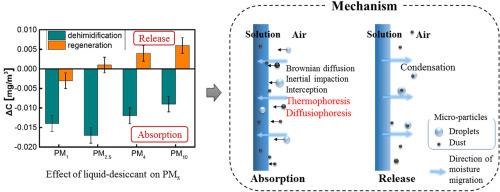Building and Environment ( IF 7.1 ) Pub Date : 2021-02-09 , DOI: 10.1016/j.buildenv.2021.107662 LYu Yue , Yin Yonggao , Zhao Xingwang , Zhang Chengbin

|
Liquid desiccant is a new means of controlling air humidity with significant energy-saving potential. However, direct contact between the salt solution and the treated air may cause carryover droplets that degrade the indoor air quality, and this is a major obstacle to widespread application. This paper experimentally investigates how dehumidification and regeneration using LiCl solution affect the mass concentration of micro-particles in the treated air. The results show that dehumidification tends to remove micro-particles with sizes of 0–2.5 μm rather than carryover droplets, especially for PM2.5 by 7.73%. However, larger micro-particles with sizes of 2.5–10 μm are generated during regeneration of the liquid desiccant, which indicates that the change in the amount of micro-particles depends on the direction of moisture migration. Increasing the rate of air or solution flow increases moisture migration during regeneration to release more micro-particles. Additionally, the amount of micro-particles released during counter flow is less than that during parallel flow, because the larger particles settle down during the former. This investigation should help to understand the behavior of carryover droplets in liquid-desiccant air-conditioning systems and inspire new methods for controlling humidity and particles.
中文翻译:

液体干燥剂空调工艺对空气中可吸入颗粒物存在的影响
液体干燥剂是一种控制空气湿度的新方法,具有巨大的节能潜力。然而,盐溶液与处理后的空气之间的直接接触可能会导致残留液滴,从而降低室内空气质量,这是广泛应用的主要障碍。本文实验研究了LiCl溶液的除湿和再生如何影响处理后空气中微粒的质量浓度。结果表明,除湿倾向于去除尺寸为0–2.5μm的微粒,而不是残留的液滴,特别是对于PM 2.5减少了7.73%。但是,在液体干燥剂的再生过程中会生成尺寸为2.5–10μm的较大微粒,这表明微粒数量的变化取决于水分迁移的方向。空气或溶液流量的增加会增加再生过程中的水分迁移,从而释放出更多的微粒。另外,在逆流期间释放的微粒数量少于在平行流动期间释放的微粒数量,因为较大的微粒在前者期间沉降下来。这项研究应有助于了解液体干燥剂空调系统中残留液滴的行为,并激发出控制湿度和颗粒物的新方法。











































 京公网安备 11010802027423号
京公网安备 11010802027423号